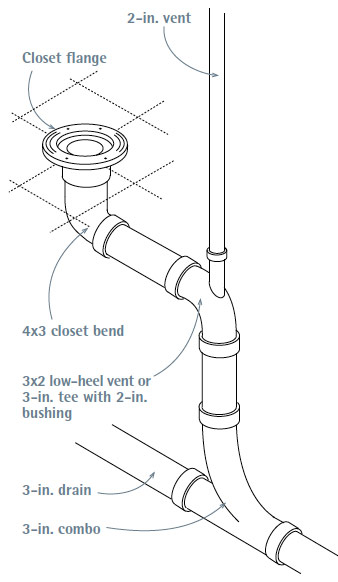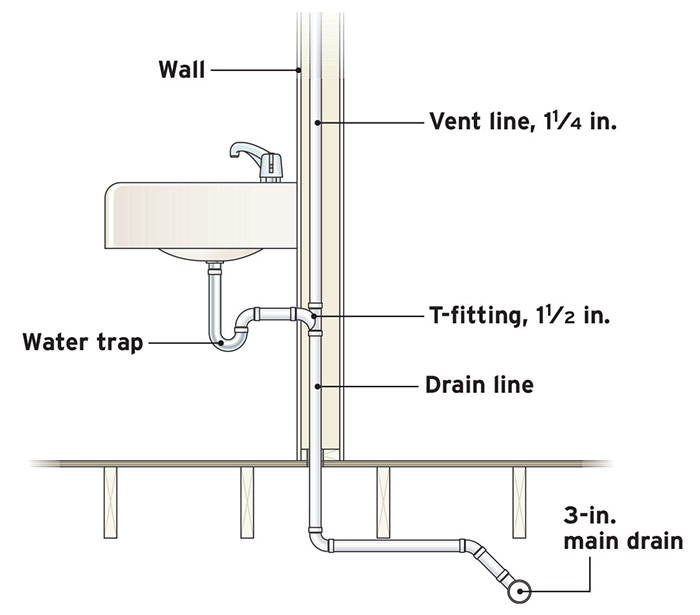What're your thoughts and feelings on What Is a Plumbing Vent and Why Is It Important?

Appropriate air flow in pipes systems is frequently overlooked, yet it is essential for keeping the capability and security of your home's plumbing. Ventilation assists control air pressure, stop the build-up of damaging gases, and guarantee the reliable removal of waste. In this overview, we will certainly check out the significance of correct pipes ventilation, just how it works, and the advantages it gives your plumbing system.
Just How Air Flow Functions in Pipes Systems
Air Pressure Law
Correct air flow maintains balanced air pressure within the plumbing system. When water flows through pipelines, it displaces air. Without adequate air flow, this variation can create unfavorable stress, leading to slow drains or siphoning of water from traps, which can create unpleasant odors to seep into the home.
Protecting Against Sewer Gas Accumulation
Among the most crucial features of pipes vents is to avoid sewer gases, such as methane and hydrogen sulfide, from gathering within the home. These gases can posture serious wellness dangers and are very combustible. Vent pipelines enable these gases to escape safely outside.
Aiding in Waste Elimination
Air flow assists in the reliable removal of wastewater by protecting against airlocks in the water drainage system. When air can stream easily with the vents, it allows water and waste to move efficiently through the pipes, reducing the danger of blockages and back-ups.
Benefits of Correct Ventilation
Boosted System Performance
Appropriately aerated pipes systems run extra efficiently, with less obstructions, faster draining, and much less stress on the pipelines. This performance extends the life expectancy of the pipes system.
Improved Air High Quality
By preventing drain gases from entering your home, proper air flow adds to much better indoor air high quality, making your living environment healthier and extra comfortable.
Avoiding Water Damage
Sufficient ventilation aids stop water from being siphoned out of catches, which can cause sewer gases getting in the home and causing water damages gradually.
Actions to Make Certain Correct Air Flow
Consulting Plumbing Codes
Always seek advice from regional pipes codes when making or changing your plumbing system. These codes supply the required standards for appropriate airing vent and guarantee your system meets safety standards.
Routine Inspection and Upkeep
Regular evaluations can assist determine potential ventilation issues before they become significant issues. Upkeep tasks, such as cleaning vent pipelines and checking for clogs, are crucial for maintaining the system in good working order.
Expert Installment
For brand-new installations or major alterations, it's important to employ an expert plumbing technician. They have the know-how to guarantee the ventilation system is correctly developed and mounted according to code.
Recognizing Ventilation in Plumbing
Air flow in pipes describes the network of pipelines that enable air to move via the drainage system. These vents serve several purposes, including regulating atmospheric pressure within the pipelines, preventing sewage system gases from getting in the home, and helping in the smooth circulation of wastewater.
Kinds Of Plumbing Vents
Key Stack Vent
The major pile vent, additionally called the air vent pile, is the key vent in a pipes system. It expands from the main drainpipe align through the roofing system, allowing gases to leave and fresh air to enter the system.
Branch Vent
Branch vents attach to the primary stack vent and offer private fixtures, such as sinks, commodes, and showers. These vents make sure that each fixture has adequate ventilation to work correctly.
Air Admission Valve (AAV).
An Air Admission Valve (AAV) is a one-way shutoff that enables air to get in the pipes system without the demand for a traditional vent pipeline expanding via the roofing. AAVs are frequently utilized in remodellings or locations where setting up a conventional air vent is impractical.
Signs of Poor Air Flow in Plumbing.
Slow Draining Fixtures.
If your sinks, bathtubs, or bathrooms are draining pipes gradually, maybe an indicator of bad ventilation. Insufficient air circulation can produce a vacuum cleaner impact, making it difficult for water to drain pipes properly.
Gurgling Seems.
Gurgling noises coming from drains pipes are typically a result of air being sucked with water traps as a result of unfavorable pressure in the pipes. This is a clear indication of not enough air flow.
Undesirable Smells.
Sewer smells inside your home are a warning that your plumbing system is not effectively aerated. This might mean that sewer gases are not being effectively vented outside, resulting in potentially hazardous conditions.
Typical Air Flow Mistakes.
Insufficient Vent Sizing.
Making use of undersized vent pipes can lead to poor air circulation and stress inequalities in the system. It's essential to use vents that satisfy the particular requirements of your plumbing system.
Improper Vent Positioning.
Putting vents too much from the components they offer can lower their efficiency. Appropriate placement guarantees that air can stream openly and successfully via the system.
Disregarding Code Demands.
Building regulations supply particular guidelines for pipes ventilation. Overlooking these codes can result in a system that falls short to function properly and may bring about costly repair services or carcinogen.
Final thought.
Correct air flow is an important part of any type of pipes system, making sure that it works effectively and securely. By comprehending the significance of ventilation, identifying the indications of poor air flow, and taking actions to keep your system, you can protect against expensive issues and safeguard your home's air high quality.
4 Things You Should Know About Your Plumbing Vents
What Plumbing Vents Are
Also called a vent stack, a plumbing vent is a vertical pipe attached to your drain line that runs through your roof. The plumbing vent pipe, or plumbing air vent, removes gas and odors from your plumbing system and allows fresh air to enter the pipes, helping the water to flow out of the drain pipes.
What Plumbing Vents Do
Plumbing vents have two basic functions. One of which is to allow unpleasant smelling wastewater and sewer gasses to escape your plumbing system instead of entering your home. Plumbing vent pipes are typically located on roofs, away from windows, to ensure the fumes exit the home completely.
The other function of the plumbing vent is to move fresh air into your plumbing system. This helps move water through every plumbing fixture in your house, like toilets and sink drains. Think of the way in which you need to let a little air into the bottle as you pour soda in order to make the drink flow smoothly.
Different Types of Plumbing Vents
True vent: This is the most common vent option. In simplest terms, a true vent is a vertical pipe attached to your drain line that exits through the roof. They often function as the main vent that other fixtures can connect to. Re-vent pipe or auxiliary vent: Attached to the drain line near specific plumbing fixtures, re-vent pipes run up and over to connect to the main vent. Common vent: Two plumbing fixtures installed on opposite sides of a wall are typically tied into the vent stack using something known as a sanitary cross. Wet vent: This venting option operates as a drain pipe and a vent at the same time. Wet vent drainage systems drain water from one fixture while venting the air from another. Although they’ve been used for over 100 years, wet vent systems have only recently been added to the plumbing code in many areas. If you’re planning on installing one in a bathroom remodel, make sure you check your local code prior to construction. Loop vent: For free-standing fixtures like kitchen island sinks, loop vents are ideal. These vent pipes run under the floor, rise from the P-trap, and create a loop inside the cabinet sink. Air admittance valve: An AAV is a one-way mechanical valve typically installed at the site of the plumbing fixture. AAVs allow venting to occur without having to tie into a larger venting system. They’re ideal for venting fixtures where you aren’t able to easily connect to an existing vent system. Common Plumbing Vent Issues
Although vent pipes typically don’t have water flowing through them, they’re still subject to many typical plumbing issues. For example, clogs are one of the most common problems associated with sewer vent pipes. If your vent pipe gets clogged, all of your plumbing fixtures tied into the vent stack will be affected.
A sink with a slow drain that bubbles and gurgles or a strong sewage smell around your toilet are both indicators that your toilet vent pipe is clogged. Because most vent pipes exit through the roof, old leaves, twigs or even a bird’s nest could be clogging the pipe.
Clogs in your vent pipe system cause a buildup of negative pressure, meaning that water won’t be able to flow out of your home very well. It’s similar to putting your finger over the opening of a straw to trap water inside. When you remove your finger, the water is able to flow out of the straw.
If you suspect you have any blockage in your vent, make sure you have a professional come examine the situation. Left unchecked, a blocked air vent can lead to other costly repairs, like leaks and sediment buildup.
Under Pressure
Pipe vents are essential aspects of a home’s plumbing system. Owning a home means learning about all sorts of things you never put much thought into before. But by understanding as much as you can about the important systems of your home, you can keep those budgets intact and those anxiety levels low.
https://www.homeserve.com/en-us/blog/home-improvement/plumbing-vents/

I came across that blog posting on What Is A Plumbing Vent & How Do They Work? when perusing the internet. For those who appreciated our blog post kindly do not forget to pass it around. I treasure reading our article about What Are Plumbing Vents and Why Are They Important?.
Call Today